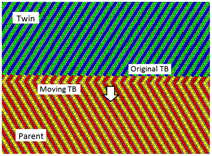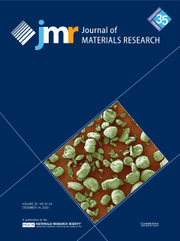Article contents
Shear and shuffle in  $\left\{ {{\bf 11}\bar {\bf2}{\bf 2}} \right\}\left\langle {{\bf11}\bar {\bf 2}\bar {\bf 3}} \right\rangle$ twinning in titanium
$\left\{ {{\bf 11}\bar {\bf2}{\bf 2}} \right\}\left\langle {{\bf11}\bar {\bf 2}\bar {\bf 3}} \right\rangle$ twinning in titanium
Published online by Cambridge University Press: 22 December 2015
Abstract

In classical twinning theory, the K 2 plane of  $\left\{ {11\bar 22} \right\}\left\langle {11\bar 2\bar 3} \right\rangle$ twinning mode was predicted to be
$\left\{ {11\bar 22} \right\}\left\langle {11\bar 2\bar 3} \right\rangle$ twinning mode was predicted to be  $\left\{ {11\bar 2\bar 4} \right\}$ , with a twinning shear of ∼0.22 which was experimentally “confirmed”. However, these twinning elements cannot be reproduced or verified in atomistic simulations. The K 2 plane in the simulations is always (0001), but this K 2 plane would lead to a nominal twining shear of 1.26 which is unrealistically large. In this work, atomistic simulations were performed to investigate the migration of
$\left\{ {11\bar 2\bar 4} \right\}$ , with a twinning shear of ∼0.22 which was experimentally “confirmed”. However, these twinning elements cannot be reproduced or verified in atomistic simulations. The K 2 plane in the simulations is always (0001), but this K 2 plane would lead to a nominal twining shear of 1.26 which is unrealistically large. In this work, atomistic simulations were performed to investigate the migration of  $\left\{ {11\bar 22} \right\}$ twin boundary in titanium (Ti). Shear and atomic shuffles for three different, reported K 2 planes were analyzed in great detail, for the first time. The analyses show that
$\left\{ {11\bar 22} \right\}$ twin boundary in titanium (Ti). Shear and atomic shuffles for three different, reported K 2 planes were analyzed in great detail, for the first time. The analyses show that  ${K_2} = \{ 11\bar 2\bar 4\}$ leads to very complex shuffles despite the small twinning shear and is unfavorable. If
${K_2} = \{ 11\bar 2\bar 4\}$ leads to very complex shuffles despite the small twinning shear and is unfavorable. If  ${K_2} = \{ 11\bar 2\bar 2\}$ , only half of the parent atoms are involved in the shuffling, but the twinning shear is very large (0.96) and is also unfavorable. When K 2 = (0001), the parent atoms are carried to twin positions partly by shear and partly by a simple shuffle. Because shuffling makes no contribution to the twinning shear, the actual twinning shear is 0.66, instead of 1.26. Thus, K 2 = (0001) is the most favorable and the conflict between the simulation results and the classical twinning theory can be reconciled.
${K_2} = \{ 11\bar 2\bar 2\}$ , only half of the parent atoms are involved in the shuffling, but the twinning shear is very large (0.96) and is also unfavorable. When K 2 = (0001), the parent atoms are carried to twin positions partly by shear and partly by a simple shuffle. Because shuffling makes no contribution to the twinning shear, the actual twinning shear is 0.66, instead of 1.26. Thus, K 2 = (0001) is the most favorable and the conflict between the simulation results and the classical twinning theory can be reconciled.
Information
- Type
- Articles
- Information
- Copyright
- Copyright © Materials Research Society 2015
Footnotes
Contributing Editor: Susan B. Sinnott
References
REFERENCES
- 3
- Cited by

